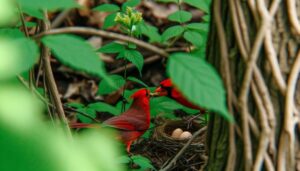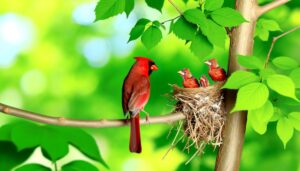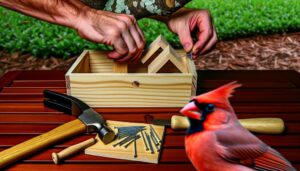5 Tips to Get Cardinals to Nest in Your Yard
To get cardinals to nest in your yard, provide dense shrubbery and native plants like dogwoods and elderberries. Make sure there's accessible water and a variety of food sources, including seeds, fruits, and insects.
Place nesting materials such as twigs and grass in easily accessible areas. Position feeders and birdbaths away from foot traffic and open spaces.
Install predator guards and choose elevated spots for nests. Maintaining a quiet, protected environment with layered vegetation can further encourage cardinals to choose your yard for nesting.
These steps can transform your yard into a cardinal haven. Discover how minor tweaks make a big impact.
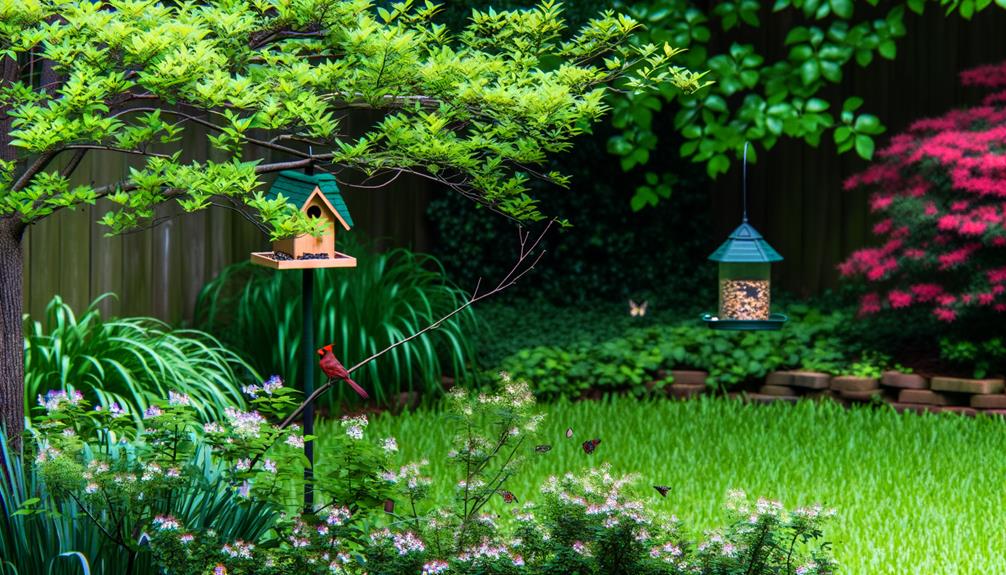
Key Takeaways
- Plant dense shrubs and native vegetation to provide year-round cover and food.
- Position nests and feeders in elevated, quiet locations away from heavy foot traffic.
- Provide a variety of nesting materials like twigs, grass, and pine needles in accessible spots.
- Ensure a nearby water source, such as a birdbath, for drinking and bathing.
- Install predator guards and choose plants with spiky foliage to protect nesting areas.
Understand Cardinal Preferences

To attract cardinals to nest in your yard, understanding their specific habitat preferences is crucial, which include dense shrubbery for cover, a variety of food sources, and accessible water.
Cardinals favor thick vegetation, such as hedges or brambles, to conceal their nests from predators. They thrive on a diet of seeds, fruits, and insects, so incorporating diverse plant species that provide these food sources will entice them.
Additionally, cardinals require a steady supply of fresh water for drinking and bathing. Installing a birdbath or a small water feature can fulfill this need.
Choose the Right Location
Selecting a best nesting site in your yard involves considering the cardinal's need for safety, food, and water proximity. You'll want to make sure that the location is both safe from predators and within easy reach of essential resources. This balance is essential for attracting cardinals to your yard.
Here's a detailed guide to help you choose the ideal spot:
- Safety: Position the nesting site away from heavy foot traffic and keep it elevated to deter ground predators.
- Food Sources: Confirm the location is near natural food sources, like berry bushes, or place feeders nearby.
- Water Access: Cardinals need water for drinking and bathing. A nearby birdbath or small pond will make your yard more appealing.
Provide Natural Shelter

To offer natural shelter for cardinals, you should plant dense shrubs that offer protection and nesting sites.
Maintaining native trees supports the local ecosystem and gives cardinals familiar places to nest.
Adding evergreen trees guarantees year-round cover, providing a reliable refuge during different seasons.
Plant Dense Shrubs
Planting thick shrubs like dogwoods, hollies, and viburnums creates necessary natural shelters that cardinals need for nesting and protection. These shrubs provide dense foliage, which offers both cover from predators and a suitable environment for nest building.
To successfully attract cardinals, consider the following:
- Diversity: Incorporate a variety of shrubs to guarantee year-round cover and food sources.
- Layering: Plant shrubs in layers to mimic natural habitats, offering multiple levels of protection.
- Maintenance: Regularly prune and care for your shrubs to keep them healthy and thick, which sustains their effectiveness as shelter.
Maintain Native Trees
Maintaining indigenous trees in your yard is essential for providing cardinals with natural shelter and enhancing their nesting opportunities. Indigenous trees like oaks, maples, and dogwoods offer cardinals the ideal environment for building their nests. These trees are adapted to your local ecosystem, guaranteeing they provide the right type of foliage and insects that cardinals rely on for food.
Regularly prune dead branches to maintain tree health and secure dense, protective canopies. Avoid using pesticides that could harm the natural insect population. By preserving these indigenous trees, you create a stable habitat that supports not just cardinals, but a diverse array of wildlife, fostering a vibrant, self-sustaining ecosystem right in your own yard.
Add Evergreen Trees
Evergreen trees, with their year-round foliage, provide essential cover and safe nesting sites for cardinals even during the harshest weather conditions. To attract cardinals, consider adding these trees to your yard. Here's how they help:
- Protection from Predators:
Dense branches give cardinals a safe haven from predators, ensuring they feel secure.
- Winter Shelter:
Evergreen trees maintain their needles throughout the year, offering warmth and protection during winter storms.
- Nesting Sites:
The thick foliage provides ideal locations for cardinals to build their nests, away from harsh elements and disturbances.
Offer Nesting Materials
To attract cardinals, provide natural fiber sources like twigs, grass, and pine needles. Guarantee these materials are placed in locations that mimic safe nesting sites, away from predators and harsh weather.
Natural Fiber Sources
Providing natural fiber sources like twigs, grass, and yarn in your yard can greatly enhance the chances of cardinals choosing to nest there. These materials mimic what cardinals naturally seek out for their nests. To make your yard more appealing, scatter these items in easily accessible locations.
Here are three effective natural fiber sources:
- Twigs: Offer small, flexible twigs that cardinals can weave into sturdy nests.
- Grass clippings: Fresh or dried grass provides a soft, insulating layer for the nest.
- Yarn snippets: Cut yarn into 4-6 inch pieces; cardinals use these for lining their nests.
Safe Nesting Sites
While offering natural fibers is important, ensuring you have safe nesting sites is equally vital for attracting cardinals to your yard. Position dense shrubs or small trees in your garden to provide natural cover. Cardinals prefer nesting in thickets or dense foliage, typically 3-10 feet above the ground.
Opt for native plants like dogwoods, hawthorns, or serviceberries, which offer both shelter and food sources. Avoid placing nests near busy areas or where predators like cats might roam. You can also install nesting platforms, ensuring they're stable and hidden within foliage.
Plant Native Vegetation
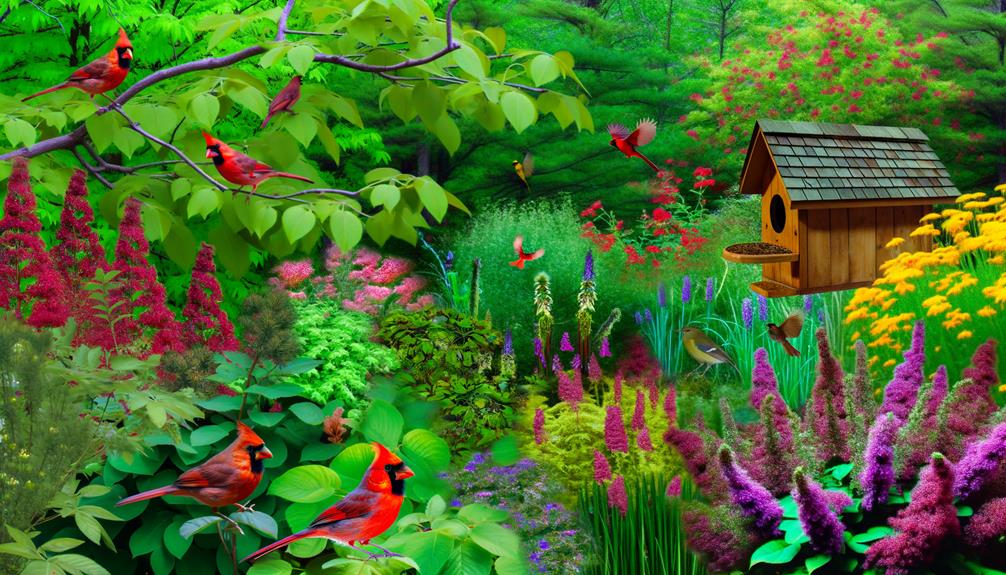
Incorporating native plants such as dogwoods, elderberries, and sumacs into your yard's landscape creates an ideal habitat for cardinals. These plants provide essential food sources and dense cover, which are vital for nesting and protection from predators.
To maximize your yard's appeal to cardinals, follow these steps:
- Diverse Planting: Guarantee a variety of native plants to offer year-round food and shelter.
- Layered Vegetation: Use a mix of trees, shrubs, and ground cover to create multiple layers of habitat, mimicking natural environments.
- Maintenance: Regularly prune and care for your plants to keep them healthy and vibrant.
Set Up Bird Feeders
To attract cardinals effectively, install bird feeders specifically designed to accommodate their feeding habits and preferences. Choose feeders with large perches and feeding ports to support their medium-sized bodies. Opt for hopper or platform feeders, as these types offer better accessibility.
Fill the feeders with cardinal-preferred seeds like sunflower seeds, safflower seeds, and peanuts. Position the feeders in quiet, sheltered areas to reduce stress and predation risk. Confirm the feeders are at least five to six feet above the ground and close to dense shrubs or trees, providing quick cover.
Clean the feeders regularly to prevent mold and disease. By meeting their specific needs, you'll create an inviting environment that encourages cardinals to visit and nest in your yard.
Supply Fresh Water

Providing a consistent source of fresh water is essential for attracting cardinals and supporting their hydration and bathing needs. You can enhance your yard's appeal by installing birdbaths or small water features.
Here's how to do it effectively:
- Keep Water Clean: Change the water daily to prevent stagnation and the growth of harmful bacteria.
- Use Shallow Basins: Cardinals prefer shallow water, about 1-2 inches deep, to drink and bathe comfortably.
- Add Moving Water: Install a small fountain or dripper; moving water is more attractive to cardinals and discourages mosquito breeding.
Ensure Safety From Predators
Creating a safe environment for cardinals involves strategically placing nesting sites away from common predators like cats and hawks. Position nests in dense shrubs or thorny bushes where cardinals can find cover. Elevated locations, around 5-15 feet high, deter ground predators. Plants like roses or holly offer natural protection with their spiky foliage.
Install predator guards on trees or poles to prevent snakes and squirrels from reaching nests. Avoid feeders or birdbaths in open areas where hawks can easily spot cardinals. Regularly check for signs of predators and adapt your setup as needed.
Maintain a Quiet Environment
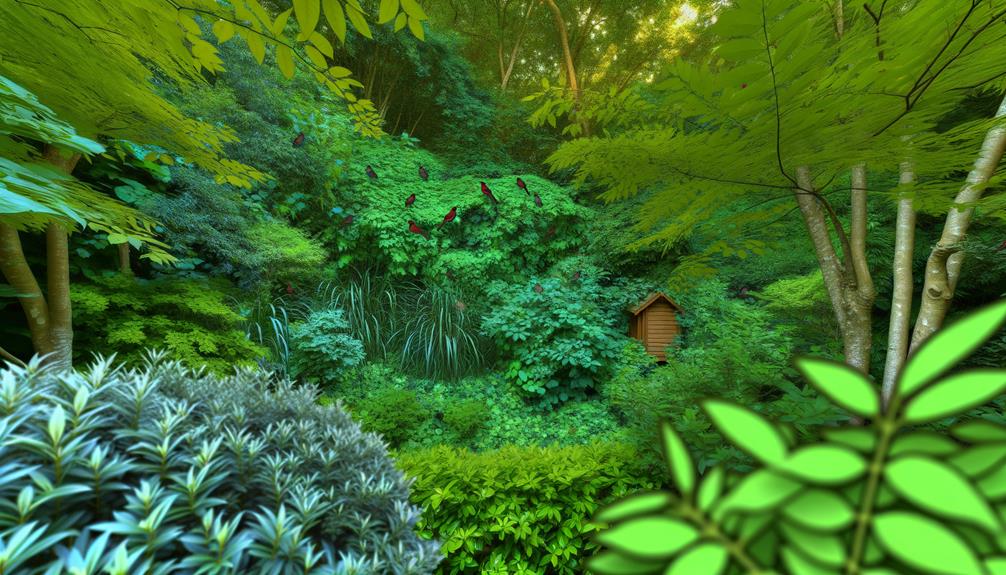
Minimizing loud noises and disturbances in your yard is essential for encouraging cardinals to nest. Cardinals are sensitive to their environment and prefer tranquil settings for nesting. By reducing noise levels, you can create a more appealing habitat.
Consider these strategies:
- Limit loud activities:
Avoid using loud machinery like lawnmowers or leaf blowers near nesting sites.
- Create buffer zones:
Plant dense shrubs or install fences to block out noise from neighboring properties.
- Schedule quiet times:
Plan quiet periods, especially during early morning and late afternoon when cardinals are most active.
Conclusion
By following these steps, you'll create an ideal haven for cardinals in your yard.
Position feeders with precision, and thoughtfully provide nesting materials and native plants.
Guarantee fresh water is always available and maintain a calm, predator-free environment.
With a bit of effort, your yard will become a cardinal paradise, where these vibrant birds can thrive and delight you with their presence.
Remember, a little care goes a long way in making your yard a cardinal's dream home.

